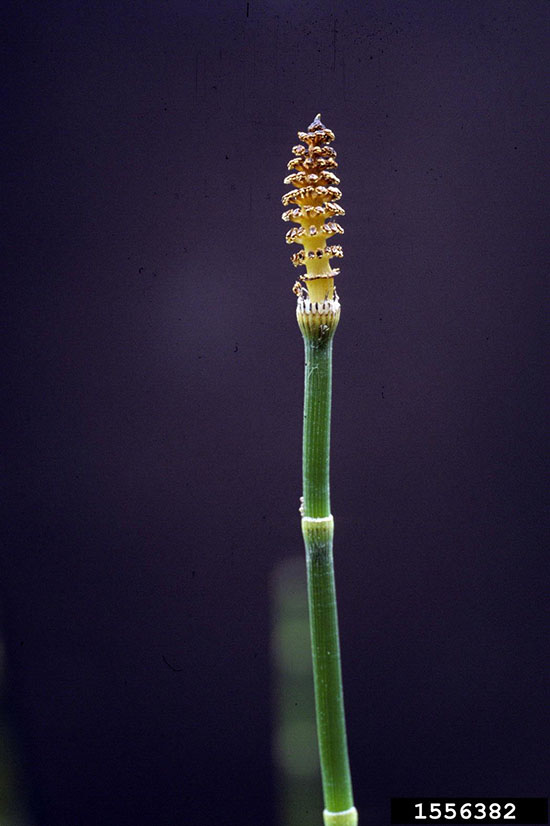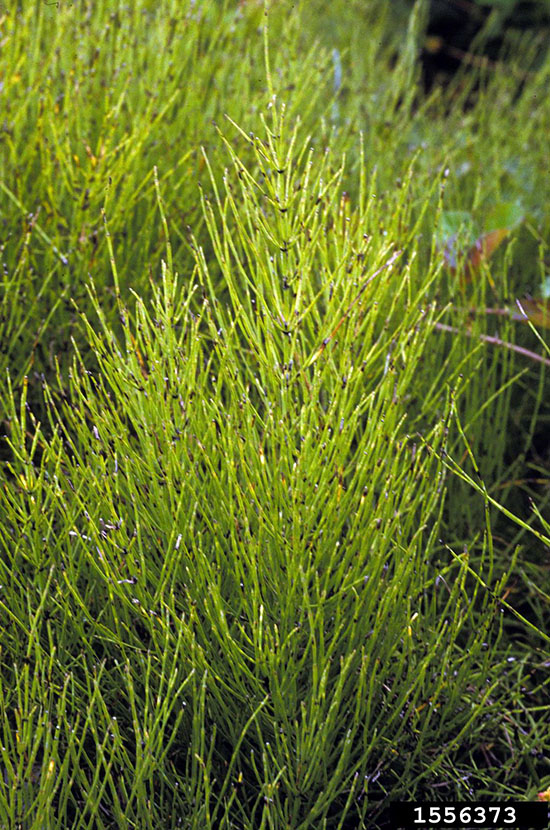Issue 9, June 25, 2018
Field Horsetail – A Unique but Aggressive Plant
Field Horsetail (Equisetum arvense) is an herbaceous perennial with a bottlebrush appearance. Other names include bottle-brush, snake-grass, horsepipes, and scouring-rush. This primitive native to North America is mostly leafless yet the cone-bearing stem has been widely used to scour or clean pans, to serve as sandpaper, and to polish metal as horsetail is rich in silica.
Horsetail is typically found growing in wet, sandy, or gravelly soil. It is often found along roadsides and railroads as well as in fields and pastures. This plant can occasionally be found in the landscape – sometimes wanted and sometimes not. In my position, I hear about the latter most often with desperate clients who want it gone. There are nurseries and landscape centers that sell horsetail. This plant can be a striking addition to a landscape. However, it can also take over and spread to neighboring sites.
Horsetail has a distinct appearance. The stems, which grow to 1 foot or more, are green, waxy, erect, hollow, tough, wiry, jointed, grooved, and either fertile or sterile. Fertile stems produce terminal fruiting heads and are not branched. This reproductive stage looks like a stovepipe with segments that snap apart. Sterile stems in the vegetative stage have lateral branches in whorls around the main stem. They resemble a small evergreen or horsetail. Both stages can be found growing in the same area at the same time, however the reproductive stage is typically found before the vegetative stage.

Field horsetail fruiting head. Photo by John Cardina, The Ohio State University, Bugwood.org.
Leaves are found on sterile stems only. They are in the form of cup-shaped, toothed sheaths at the joints. The fruiting heads are dark brown and are similar in structure to small pinecones. Horsetail reproduces by spores rather than seeds, and rhizomes that bear tubers.
Horsetail can spread impressively fast. Rhizomes are dark brown and can be 300 feet long (Czarapata, 2005)! The rhizome and tuber system of this plant may extend to 6 feet deep with internodes approximately 4 to 5 inches apart. This system then can spread from one rhizome stem to cover an area of 2.5 acres over a six-year period (Cloutier and Watson, 1985)!
Horsetail is a challenging weed to control. Challenging. I have joked with clients that they should simply consider selling the house and moving or pouring concrete over the area. The rhizomes can grow VERY deep. One could dig and remove affected soil to at least 6 feet, but that sounds like a big job – still easier than moving I suppose. Because the rhizomes can spread, tillage should be avoided. Many have had good success with repeated cutting or pulling which weakens the plant over time. Also, removing the first stems in early spring about 2 weeks after emergence will help prevent spore spread. Be careful not to compost plant parts to prevent the spread of spores and rhizomes. Some research suggests that goats will feed on horsetail. For small areas, plastic mulch or landscape fabrics can be used. However, the rhizomes have been known to run along the edge of these materials. For long-term control, cutting back on irrigation amounts and improving drainage should help.
Fertility practices should be evaluated. Dolomitic lime is a popular home remedy touted online. However, applying too much magnesium (found in dolomitic lime) can lead to other problems with your site. The soil pH and mineral levels should be determined by a soil test before applying any fertilizer or soil amendment. There are types of lime available, which do not contain magnesium such as calcitic lime. Still, there seems to be some disagreement in the literature as to whether horsetail prefers acidic soils or slightly basic. Unfortunately, horsetail can be found growing on many different soils.

Field horsetail plant. Photo by John Cardina, The Ohio State University, Bugwood.org.
Also, you could try to encourage growth of other plants to help shade out horsetail as it does not tolerate dense shade. Concrete or metal barriers can be used to keep populations from spreading into neighboring areas. Obviously, if horsetail moves into an area, act quickly and do not allow it to become established.
With horsetail, a chemical control will likely be your best control, even with the lack of leaf tissue and waxy cuticle. Be aware that complete control may take a few years to achieve. Check the product label first to ensure the product is labeled for use in your particular area (lawn, landscape bed, field crops, pasture, rights-of-way, aquatic, etc.). Apply when plants are young and actively growing. Due to variation among species, a herbicide that works well on one population may not work as well on another. Systemic herbicides that move within the plant down to the roots will be best. Herbicidal vinegars are a popular home remedy but are only able to burn down the top growth – if they are strong enough. Active ingredients that have been used with some success include: 2,4-D, halosulfuron, glyphosate, MCPA, triclopyr, diclobenil, chlorsulfuron, and sulfometuron.
Glyphosate is very water soluble and results are mixed for this herbicide on waxy horsetail. Direct injection may be used with products such as Roundup Pro. The label provides specifics but essentially the herbicide is injected into the hollow stem using a calibrated syringe.
Be sure to protect desirable plants by keeping herbicide away from them. Please read and follow all label directions. (Michelle Wiesbrook)
References
Czarapata, E. 2005. Invasive Plants of the Upper Midwest.
Cloutier, D. and A. Watson. 1985. Growth and regeneration of field horsetail (Equisetum arvense). Weed Science 33:358-365.
Nordby, D. 2005. Field Horsetail Biology and Control. The Bulletin.
Baker Lime website: https://www.bakerlime.com/calcitic-lime-vs-dolomite-lime/
Author:
Michelle Wiesbrook